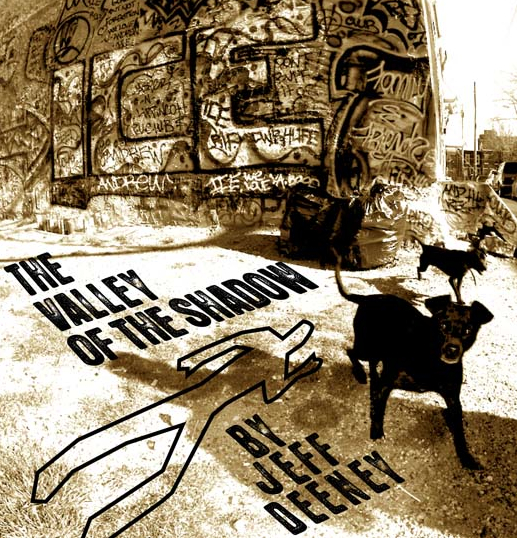
EDITOR’S NOTE: In today’s edition of the Daily News, Dana DiFilippo takes an in-depth look at the shadowy world of illegal gun-trading, how weapons get in the hands of the young and the reckless and the damage done. One of the names that figures in the story is Nazir Gary, aka ‘Nazzy,’ who was gunned down in 2007 and subsequently became one of the subjects of Jeff Deeney’s VALLEY OF THE SHADOW series on Phawker. The following is an excerpt from DiFilippo’s must-read story and the installment of VOS that ran back in 2007.
 DAILY NEWS: In the life of Nazir Gary, Theresa Jones seems like a bit player. At the time of his slaying, Gary had his own set of problems. He’d been arrested in the armed robbery of an acquaintance two months earlier and was out on bail, awaiting a preliminary hearing. Ironically, the charges against him included gun offenses. As Gary drove down 52nd Street near Kingsessing on Dec. 22, 2007, Raymond Hainey stepped out of the shadows and blasted some bullets his way. Gary, who lived two blocks away with his mother and grandmother, died a half-hour later at the Hospital at the University of Pennsylvania.
DAILY NEWS: In the life of Nazir Gary, Theresa Jones seems like a bit player. At the time of his slaying, Gary had his own set of problems. He’d been arrested in the armed robbery of an acquaintance two months earlier and was out on bail, awaiting a preliminary hearing. Ironically, the charges against him included gun offenses. As Gary drove down 52nd Street near Kingsessing on Dec. 22, 2007, Raymond Hainey stepped out of the shadows and blasted some bullets his way. Gary, who lived two blocks away with his mother and grandmother, died a half-hour later at the Hospital at the University of Pennsylvania.
Hainey fled, and, for awhile, the case sat unsolved. But Hainey ignored one key killers’ canon: Ditch the murder weapon. Two weeks after Gary’s death, two cops on routine patrol pulled Hainey and a buddy over for unspecified suspicious activity in Southwest Philadelphia, according to court records. During questioning, Hainey got nervous, brandished his gun and tried to “rock,” or kill, the cops, according to court records.
The officers wrestled the weapon away from him and chucked him into federal prison, where the chatty Hainey made plenty of incriminating statements to fellow inmates. He told one that he had shot Gary because he thought – mistakenly – that Gary had shot Hainey’s little brother. He lamented that he hadn’t gotten rid of the gun after Gary’s death, and worried whether ballistics tests would link the murder to him. Ballistics tests did prove that the gun Hainey drew on police was used to kill Gary, and investigators charged Hainey with murder. He pleaded guilty and now is serving 15 to 30 years at the state prison in Camp Hill, according to court records. MORE
THE VALLEY OF THE SHADOW: 54th & Kingsessing
[Photos by JUSTIN ROMAN]
 BY JEFF DEENEY We discovered the pile of teddy bears gathered around the base of a stop light at 54th and Kingsessing while on our way to the scene of another recent homicide in Southwest Philly. This wasn’t the first time we stumbled upon a street memorial by accident while en route to another site; it isn’t surprising in this extremely violent part of town, and especially not along Kingsessing Avenue, which has had a double-digit number of shootings and homicides along its length over the last two years. A clue as to who is memorialized can be found on one of the bears: “I miss you Nazzy,” written in fading black letters on a pink heart.
BY JEFF DEENEY We discovered the pile of teddy bears gathered around the base of a stop light at 54th and Kingsessing while on our way to the scene of another recent homicide in Southwest Philly. This wasn’t the first time we stumbled upon a street memorial by accident while en route to another site; it isn’t surprising in this extremely violent part of town, and especially not along Kingsessing Avenue, which has had a double-digit number of shootings and homicides along its length over the last two years. A clue as to who is memorialized can be found on one of the bears: “I miss you Nazzy,” written in fading black letters on a pink heart.
From here it’s easy enough to find the memorial page for Nazzy on MySpace. The first comment on the page, a simple, “R.I.P NAZ” dates back to Dec. 23 of last year. It’s worth noting that all of the Myspace profiles described in this series, including those with incriminating pictures of hand guns and automatic weapons, are public profiles viewable by any member of the site. The dates of the first comments on Nazzy’s page are all that’s needed to locate the crime report from the morning after Nazir Gary was shot only two blocks from his home on 54th Street. It’s a typical report, four lines long, consisting of only a simple statement of identity and a notice that there were no witnesses, no suspects and no motive.
What really gives a glimpse into Nazzy’s world more than the pictures in his Myspace profile — most of which show him with various members of his crew flashing five fingers on one hand and four on the other at the camera, repping 54th Street — is a comment left by an unnamed friend whose account has had its details stripped, pictures removed and set to “private.” After giving a shout out to the deceased, the friend goes on to share details about a court case that was waiting for them only one week after Nazzy’s death:
“I WENT TO OUR COURT DATE YESTERDAY…THE BITCHASS NI99A AINT SHOW UP SO THATS A GOOD THING…AND EVEN THO U COULDNT BE THERE YA FAMILY WAS STILL THERE TO SUPPORT ME…IN MY EYES WE STILL CO-D’S…[CODEFENDENTS]….AND I KNOW THINGS WILL GO IN OUR FAVOR…”
Below this comment there’s a picture of Nazzy giving the middle finger to the camera, while a light-skinned, heavily-tattooed friend of his points his clenched fist like he’s holding a gun. Clicking through the hot-linked picture brings up Nazzy’s friend’s Photobucket account containing 196 pictures documenting Thug Life in Southwest Philly. The folder contains all the requisite images: scantily-clad young girls posing, hustlers flashing thick cash knots, and teenagers out on corners after dark throwing hand signs signifying which block they’re from.
Court records reveal Nazzy’s “Co-D” to be Tabias Thompson, aka Khaos, the handle he uses online and on the street. Nazzy and Khaos were picked up for some serious shit back in October; the extensive list of charges against them includes robbery, inflicting serious bodily injury, firearms without licenses, terroristic threats . . . you get the idea. Nazzy was out on bail when he was killed; as Khaos intimated in his earlier comment, he anticipated beating his case due to lack of a witness.
Nazzy’s buddy Khaos is an enterprising young thug; he has a clothing line called “dun Derty” that he sells online and no fewer than four volumes of accompanying underground hip-hop DVDs featuring local rappers freestyling while sporting the brand. The dun Derty line includes hoodies and T-shirts with slogans like, “dun Derty University” and “Without street credit, you get . . . dun Derty.” The clothes are shown off by Khaos’ Southwest Philly friends, an attractive but rough-looking crowd including unconventional model types like young men sporting thick Muslim beards and a girl with sizeable neck, forearm and hand tattoos. A recently posted Youtube video tribute to Nazzy by Khaos and another dun Derty boy named Paso was intended as the introduction to the next DVD in the series; it’s filmed on a camcorder in what appears to be a dank and dim row home basement.
Freestyle sessions from the dun Derty DVDs are also excerpted on YouTube and prove to be road-rash raw examples of gruesome, merciless gangster rap full of gang affiliation shout outs and graphic depictions of street violence. The videos are hard to watch, but not because the kids featured in them are untalented. The videos are disturbing. These kids are mean as all fuck and practically reaching through the screen for a chance to choke you out. Their rhymes are maniacal, drenched in genuine sociopathy. There’s a clear sense of pride behind it all that says, “This is who we are, this is what we are about, and we are representing Southwest Philly.”
This is the real street shit, delivered to your safely-distanced living room courtesy of the Internet. It’s hard to conclude whether or not this is a sign of progress.
As for Nazzy’s friend Khaos, the young entrepreneur behind it all, he won’t be seeing any gains from the sale of dun Derty products in the near future. The “bitch ass nigga” that didn’t show up to court, all but ensuring that the robbery charges against him would be dropped, later filed new charges. Now Khaos has big problems. On top of the original robbery and gun charges, he’s charged with intimidating and retaliating against a witness, stalking and violating an order of protection. The charges are filed in state court, not county, which means Khaos is staring down some hard time. Currently he’s on State Road, incarcerated at the Curran Fromhold Correctional Facility while awaiting trial. His bail is set at 10 percent of $250,000.
That’s a lot of hoodies and DVDs.
 ABOUT THE AUTHOR: Jeff Deeney is a freelance writer whose work has appeared in PW, City Paper and the Inquirer. He focuses on issues of urban poverty and drug culture. He is currently working on a book about life in the crossfire of poverty, drugs, guns, and the bureaucracies designed to remedy them, all of which informed his experiences as social workers in some of the city’s most dire and depleted neighborhoods.
ABOUT THE AUTHOR: Jeff Deeney is a freelance writer whose work has appeared in PW, City Paper and the Inquirer. He focuses on issues of urban poverty and drug culture. He is currently working on a book about life in the crossfire of poverty, drugs, guns, and the bureaucracies designed to remedy them, all of which informed his experiences as social workers in some of the city’s most dire and depleted neighborhoods.
